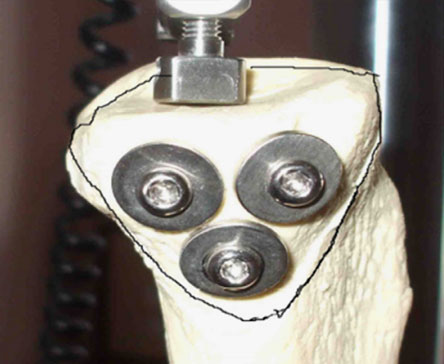H.Cift, O.Cetik, B.Kalaycioglu, M.H.Dirikoglu, K.Ozkan, F.Eksioglu
Goztepe Training and Research Hospital, Department of Orthopaedics and Traumatology, Bostanci mah. Mehmet Sevki Pasa cd. Isik apt. 32/12 Istanbul, Turkey
Kirikkale University, Department of Orthopaedics and Traumatology, Kirikkale, Turkey
Kirikkale University, Mechanical Engineering Department, 71451-Kırıkkale, Turkey
Summary
Introduction
The objective of this biomechanical study was to compare the respective efficiency of plate-screw fixation and screw fixation in an experimental model of a Schatzker type 4 fracture. Hypothesis: screw fixation and plate fixation have a similar load to failure.
Materials and methods
This study compares the stability of Schatzker type 4 medial tibial plateau fractures fixed with either 36.5 mm cancellous bone screw with a 16 mm threaded segment or with six-holed buttress T-plate-screw system. A Schatzker type 4 fracture was modeled on an artificial bone model. In a first group of 10 fracture models, following the anatomical reduction, fractures were stabilized with screws with washers. In the second group, of 10 fracture models, fractures were stabilized with T-plate. After fixation ascending axial compression was applied on bone models (Instron machine).
Results
Load bearing capacity was 1397.6 ± 194.4 N in the Group 1 and 2153.2 ± 204.4 N in the Group 2. The difference between the two groups was statistically significant (p < 0.001).
Discussion
According to this result, experimental load bearing of bone models indicate that plate-screw fixation system has a significantly higher stabilization capacity than fixation with three screws alone. Our hypothesis was not confirmed. In order to maintain anatomical repositioning, plate-screw system is a more stable fixation method than the screw in medial tibial plateau fractures Schatzker 4

